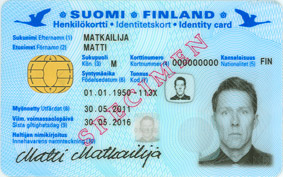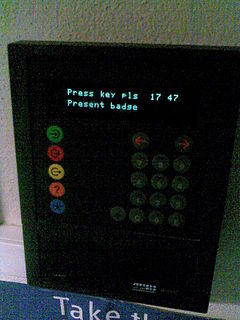
In the fields of physical security and information security, access control (AC) is the selective restriction of access to a place or other resource. The act of accessing may mean consuming, entering, or using. Permission to access a resource is called authorization.

A smart card, chip card, or integrated circuit card (ICC) is a physical electronic authorization device, used to control access to a resource. It is typically a plastic credit card sized card with an embedded integrated circuit. Many smart cards include a pattern of metal contacts to electrically connect to the internal chip. Others are contactless, and some are both. Smart cards can provide personal identification, authentication, data storage, and application processing. Applications include identification, financial, mobile phones (SIM), public transit, computer security, schools, and healthcare. Smart cards may provide strong security authentication for single sign-on (SSO) within organizations. Several nations have deployed smart cards throughout their populations.

A picture archiving and communication system (PACS) is a medical imaging technology which provides economical storage and convenient access to images from multiple modalities. Electronic images and reports are transmitted digitally via PACS; this eliminates the need to manually file, retrieve, or transport film jackets, the folders used to store and protect X-ray film. The universal format for PACS image storage and transfer is DICOM. Non-image data, such as scanned documents, may be incorporated using consumer industry standard formats like PDF, once encapsulated in DICOM. A PACS consists of four major components: The imaging modalities such as X-ray plain film (PF), computed tomography (CT) and magnetic resonance imaging (MRI), a secured network for the transmission of patient information, workstations for interpreting and reviewing images, and archives for the storage and retrieval of images and reports. Combined with available and emerging web technology, PACS has the ability to deliver timely and efficient access to images, interpretations, and related data. PACS reduces the physical and time barriers associated with traditional film-based image retrieval, distribution, and display.

Medical privacy or health privacy is the practice of maintaining the security and confidentiality of patient records. It involves both the conversational discretion of health care providers and the security of medical records. The terms can also refer to the physical privacy of patients from other patients and providers while in a medical facility. Modern concerns include the degree of disclosure to insurance companies, employers, and other third parties. The advent of electronic medical records (EMR) and patient care management systems (PCMS) have raised new concerns about privacy, balanced with efforts to reduce duplication of services and medical errors.

The Health Insurance Portability and Accountability Act of 1996 was enacted by the 104th United States Congress and signed by President Bill Clinton in 1996. It was created primarily to modernize the flow of healthcare information, stipulate how Personally Identifiable Information maintained by the healthcare and healthcare insurance industries should be protected from fraud and theft, and address limitations on healthcare insurance coverage.

A time clock, sometimes known as a clock card machine or punch clock or time recorder, is a device that records start and end times for hourly employees at a place of business.

The terms medical record, health record, and medical chart are used somewhat interchangeably to describe the systematic documentation of a single patient's medical history and care across time within one particular health care provider's jurisdiction. The medical record includes a variety of types of "notes" entered over time by health care professionals, recording observations and administration of drugs and therapies, orders for the administration of drugs and therapies, test results, x-rays, reports, etc. The maintenance of complete and accurate medical records is a requirement of health care providers and is generally enforced as a licensing or certification prerequisite.

HID Global is an American manufacturer of secure identity products. The company is a subsidiary of Assa Abloy, a Swedish global leader in door opening products.
A card reader is a data input device that reads data from a card-shaped storage medium. The first were punched card readers, which read the paper or cardboard punched cards that were used during the first several decades of the computer industry to store information and programs for computer systems. Modern card readers are electronic devices that can read plastic cards embedded with either a barcode, magnetic strip, computer chip or another storage medium.
Protected health information (PHI) under the US law is any information about health status, provision of health care, or payment for health care that is created or collected by a Covered Entity, and can be linked to a specific individual. This is interpreted rather broadly and includes any part of a patient's medical record or payment history.

Open Dental, previously known as Free Dental, is a dental practice management software licensed under the GNU General Public License. It is written in the C# programming language compatible with Microsoft .NET Framework and was first released in 2003. Current versions of the software require Microsoft Windows. Earlier versions of the software had supported other operating systems, but Linux support has been dropped. The full function version is only available under the commercial license because it includes royalty bearing, licensed materials from the American Dental Association (ADA), the Code on Dental Procedures and Nomenclature (CDT).
Patient portals are healthcare-related online applications that allow patients to interact and communicate with their healthcare providers, such as physicians and hospitals. Typically, portal services are available on the Internet at all hours of the day and night. Some patient portal applications exist as stand-alone web sites and sell their services to healthcare providers. Other portal applications are integrated into the existing web site of a healthcare provider. Still others are modules added onto an existing electronic medical record (EMR) system. What all of these services share is the ability of patients to interact with their medical information via the Internet. Currently, the lines between an EMR, a personal health record, and a patient portal are blurring. For example, Intuit Health and Microsoft HealthVault describe themselves as personal health records (PHRs), but they can interface with EMRs and communicate through the Continuity of Care Record standard, displaying patient data on the Internet so it can be viewed through a patient portal.
Digital Security refers to various ways of protecting computer's internet account and files from intrusion by an outside user.
LogLogic is a technology company that specializes in Security Management, Compliance Reporting, and IT Operations products. LogLogic developed the first appliance-based log management platform. LogLogic's Log Management platform collects and correlates user activity and event data. LogLogic's products are used by many of the world's largest enterprises to rapidly identify and alert on compliance violations, policy breaches, cyber attacks, and insider threats.
The Wall Street Transcript is a paid subscription publication and Web site that publishes bi-weekly industry reports that feature equity analyst, money manager and CEO interviews. Reports typically cover two to three industries and express money managers' and analysts' views on each of the various industry sectors, as well as interviews with CEOs whose companies operate within the covered industries.
MDLIVE is a telemedicine provider. The company provides patients, health plans, health systems and self-insured employers with access to board-certified doctors, pediatricians and licensed therapists. Consultations are performed via online video, phone or mobile app.
The Health Information Technology for Economic and Clinical Health Act, abbreviated HITECH Act, was enacted under Title XIII of the American Recovery and Reinvestment Act of 2009. Under the HITECH Act, the United States Department of Health and Human Services is spending $25.9 billion to promote and expand the adoption of health information technology. The Washington Post reported the inclusion of "as much as $36.5 billion in spending to create a nationwide network of electronic health records." At the time it was enacted, it was considered "the most important piece of health care legislation to be passed in the last 20 to 30 years" and the "foundation for health care reform."
Patient check-in is the process where patients check-in to begin their registration with the healthcare facility topically using a clipboard, electronic tablet, touch screen, kiosk, or some other method, sometimes self-service. Patient check in started as far back as the Roman times when patients would wait for special services in purpose-built hospitals. Romans were the first to have hospitals with doctors assigned to consult and observe patients. Prior to the Romans, many cultures such as the Greeks relied on temples and the Gods to cure through supernatural forces. As patient services were made more available, so was the need to have some method of tracking patients as they arrived.
Third-party management is the process whereby companies monitor and manage interactions with all external parties with which it has a relationship. This may include both contractual and non-contractual parties. Third-party management is conducted primarily for the purpose of assessing the ongoing behavior, performance and risk that each third-party relationship represents to a company. Areas of monitoring include supplier and vendor information management, corporate and social responsibility compliance, Supplier Risk Management, IT vendor risk, anti-bribery/anti-corruption (ABAC) compliance, information security (infosec) compliance, performance measurement, and contract risk management. The importance of third-party management was elevated in 2013 when the US Office of the Comptroller of the Currency stipulated that all regulated banks must manage the risk of all their third parties.
Federal and state governments, insurance companies and other large medical institutions are heavily promoting the adoption of electronic health records. The US Congress included a formula of both incentives and penalties for EMR/EHR adoption versus continued use of paper records as part of the Health Information Technology for Economic and Clinical Health (HITECH) Act, enacted as part of the, American Recovery and Reinvestment Act of 2009.








